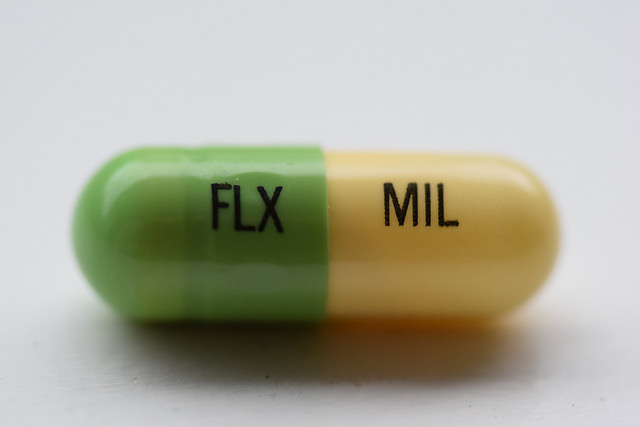Using truthful or deceiving verbal instructions, we tested how expectancies influence SSRI efficacy in social anxiety disorder. The number of responders was more than three times higher after open administration of escitalopram 20 mg compared to covert administration of the drug presented as “active placebo” in a cover story. Correct vs. incorrect information about the SSRI also yielded different neural changes in brain areas involved in emotion-cognition interactions. The benefit of SSRI medication seems to be highly affected by psychological factors like positive expectancies traditionally associated with placebo. Our results favor a biopsychosocial over a biomedical explanatory model for SSRI efficacy.
This study suggests that the presentation of a treatment may be as important as the treatment itself.
Tired of reading? Watch Professor Tomas Furmark explain the study in just 6 minutes:
Selective serotonin reuptake inhibitors (SSRIs) are commonly prescribed for depression and anxiety, but their efficacy relative to placebo has been questioned. We aimed to test how manipulation of verbally induced expectancies, central for placebo, influences SSRI treatment outcome and brain activity in patients with social anxiety disorder (SAD).
We did a randomized clinical trial, within an academic medical center (Uppsala, Sweden), of individuals fulfilling the DSM-IV criteria for SAD, recruited through media advertising. Participants were 18 years or older and randomized in blocks, through a computer-generated sequence by an independent party, to nine weeks of overt or covert treatment with escitalopram (20 mg daily). The overt group received correct treatment information whereas the covert group was treated deceptively with the SSRI described, by the psychiatrist, as active placebo. The treating psychiatrist was necessarily unmasked while the research staff was masked from intervention assignment. Treatment efficacy was assessed primarily with the self-rated Liebowitz Social Anxiety Scale (LSAS-SR), administered at week 0, 1, 3, 6 and 9, also yielding a dichotomous estimate of responder status (clinically significant improvement). Before and at the last week of treatment, brain activity during an emotional face-matching task was assessed with functional magnetic resonance imaging (fMRI) and during fMRI sessions, anticipatory speech anxiety was also assessed with the Spielberger State-Trait Anxiety Inventory – State version (STAI-S). Analyses included all randomized patients with outcome data at posttreatment. This study is registered at ISRCTN, number 98890605.
Between March 17th 2014 and May 22nd 2015, 47 patients were recruited. One patient in the covert group dropped out after a few days of treatment and did not provide fMRI data, leaving 46 patients with complete outcome data. After nine weeks of treatment, overt (n = 24) as compared to covert (n = 22) SSRI administration yielded significantly better outcome on the LSAS-SR (adjusted difference 21 ∙ 17, 95% CI 10 ∙ 69–31 ∙ 65, p < 0 ∙ 0001) with more than three times higher response rate (50% vs. 14%; χ2(1) = 6 ∙ 91, p = 0 ∙ 009) and twice the effect size (d = 2 ∙ 24 vs. d = 1 ∙ 13) from pre-to posttreatment. There was no significant between-group difference on anticipatory speech anxiety (STAI-S), both groups improving with treatment. No serious adverse reactions were recorded. On fMRI outcomes, there was suggestive evidence for a differential neural response to treatment between groups in the posterior cingulate, superior temporal and inferior frontal gyri (all z thresholds exceeding 3 ∙ 68, p ≤ 0 ∙ 001). Reduced social anxiety with treatment correlated significantly with enhanced posterior cingulate (z threshold 3 ∙ 24, p = 0 ∙ 0006) and attenuated amygdala (z threshold 2 ∙ 70, p = 0 ∙ 003) activity.
The clinical and neural effects of escitalopram were markedly influenced by verbal suggestions. This points to a pronounced placebo component in SSRI-treatment of SAD and favors a biopsychosocial over a biomedical explanatory model for SSRI efficacy.
[lightbox link=”http://www.carlbring.se/wp/wp-content/uploads/2017/10/covertovert.jpg” thumb=”http://www.carlbring.se/wp/wp-content/uploads/2017/10/covertovert.jpg” width=”389″ align=”center” title=”” frame=”true” icon=”image” caption=””]
Photo: John Campbell
Read the full paper:
Faria, V., Gingnell, M., Hoppe, J. M., Hjorth, O., Alaie, I., Frick, A., Hultberg, S., Wahlstedt, K., Engman, J., Månsson, K. N. T., Carlbring, P., Andersson, G., Reis, M., Larsson, E.-M., Fredrikson, M., & Furmark, T. (2017). Do You Believe It? Verbal Suggestions Influence the Clinical and Neural Effects of Escitalopram in Social Anxiety Disorder: A Randomized Trial. EBioMedicine, 24(Supplement C), 179-188. doi:10.1016/j.ebiom.2017.09.031
Here is a comment by Irving Kirsch in the same paper: http://www.ebiomedicine.com/article/S2352-3964(17)30392-4/fulltext
